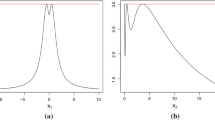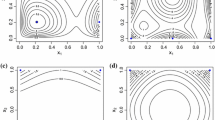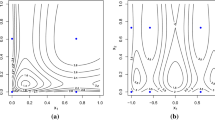Abstract
We provide lower efficiency bounds for the best product design for an additive multifactor linear model. The A-optimality criterion is used to demonstrate that out bounds are better than the conventional bounds. Applications to other criteria, such as IMSE (integrated mean squared error) criterion are also indicated. In all the cases, the best product design appears to perform better when there are more levels in each factor but decreases when more factors are included. Explicit efficiency formulas for non-additive models are also constructed.
Similar content being viewed by others
REFERENCES
Clark, V. (1965). Choice of levels in polynomial regression with one or two variables, Technometrics, 7, 325–333.
Cook, R. D. and Thibodeau, L. A. (1980). Marginally restricted D-optimal designs, J. Amer. Statist. Assoc., 75, 366–371.
Dette, H. (1996). Lower bounds for efficiencies with applications, Research Developments in Probability and Statistics, Festschrift in Honor of Madan Puri on the Occasion of his 65th Birthday (eds. E. Brunner and M. Denker), 111–124, VSP, Utrecht.
Dette, H. and Röder, I. (1996). Optimal product designs for multivariate regression with missing terms, Scand. J. Statist., 23, 195–208.
Kiefer, J. (1959). Optimum experimental designs, J. Roy. Statist. Soc. Ser. B, 21, 272–319.
Pázman, A. (1986). Foundations of Optimum Experimental Design, D. Reidel, Dordrecht.
Rafajlowicz, E. and Myszka, W. (1988). Optimum experimental design for a regression on a hypercube--generalization of Hoel's result, Ann. Inst. Statist. Math., 40, 821–827.
Rafajlowicz, E. and Myszka, W. (1992). When product type experimental design is optimal? Brief survey and new results, Metrika, 39, 321–333.
Schwabe, R. (1996). Optimum Designs for Multi-Factor Models, Lecture Notes in Statistics, Vol. 113, Springer, New York.
Schwabe, R. (1998). Optimal designs for hierarchical interaction structures, J. Statist. Plann. Inference, 70, 181–190.
Schwabe, R. and Wong, W. K. (1997). A relationship between efficiencies of marginal designs and product designs, Metrika, 45, 253–257.
Schwabe, R. and Wong, W. K. (1998). Improved lower efficiency bounds for product designs in multifactor experiments (extended version), Berichte zur Stochastik und verwandten Gebieten, No. 98-4, Johannes Gutenberg-Universität Mainz.
Wierich, W. (1989). On the relative efficiency of the best second order proportional ANOVA designs, Comput. Statist. Data Anal., 8, 119–134.
Wong, W. K. (1994). Multifactor C-optimal designs with heteroscedastic errors, J. Statist. Plann. Inference, 40, 127–133.
Author information
Authors and Affiliations
About this article
Cite this article
Schwabe, R., Wong, W.K. Efficiency Bounds for Product Designs in Linear Models. Annals of the Institute of Statistical Mathematics 51, 723–730 (1999). https://doi.org/10.1023/A:1004087314831
Issue Date:
DOI: https://doi.org/10.1023/A:1004087314831




